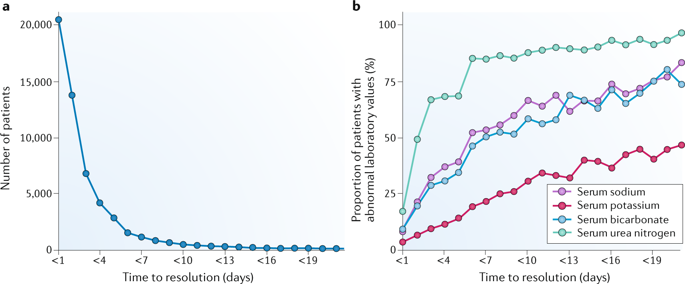当前位置:
X-MOL 学术
›
Nat. Rev. Nephrol.
›
论文详情
Our official English website, www.x-mol.net, welcomes your
feedback! (Note: you will need to create a separate account there.)
Molecular nephrology: types of acute tubular injury.
Nature Reviews Nephrology ( IF 28.6 ) Pub Date : 2019-08-22 , DOI: 10.1038/s41581-019-0184-x Beatriz Desanti De Oliveira 1 , Katherine Xu 1 , Tian H Shen 1 , Miriam Callahan 1 , Krzysztof Kiryluk 1 , Vivette D D'Agati 1 , Nicholas P Tatonetti 1 , Jonathan Barasch 1 , Prasad Devarajan 2
Nature Reviews Nephrology ( IF 28.6 ) Pub Date : 2019-08-22 , DOI: 10.1038/s41581-019-0184-x Beatriz Desanti De Oliveira 1 , Katherine Xu 1 , Tian H Shen 1 , Miriam Callahan 1 , Krzysztof Kiryluk 1 , Vivette D D'Agati 1 , Nicholas P Tatonetti 1 , Jonathan Barasch 1 , Prasad Devarajan 2
Affiliation

|
The acute loss of kidney function has been diagnosed for many decades using the serum concentration of creatinine - a muscle metabolite that is an insensitive and non-specific marker of kidney function, but is now used for the very definition of acute kidney injury (AKI). Fortunately, myriad new tools have now been developed to better understand the relationship between acute tubular injury and elevation in serum creatinine (SCr). These tools include unbiased gene and protein expression analyses in kidney, urine and blood, the localization of specific gene transcripts in pathological biopsy samples by rapid in-situ RNA technology and single-cell RNA-sequencing analyses. However, this molecular approach to AKI has produced a series of unexpected problems, because the expression of specific kidney-derived molecules that are indicative of injury often do not correlate with SCr levels. This discrepancy between kidney injury markers and SCr level can be reconciled by the recognition that many separate subtypes of AKI exist, each with distinct patterning of molecular markers of tubular injury and SCr data. In this Review, we describe the weaknesses of isolated SCr-based diagnoses, the clinical and molecular subtyping of acute tubular injury, and the role of non-invasive biomarkers in clinical phenotyping. We propose a conceptual model that synthesizes molecular and physiological data along a time course spanning from acute cellular injury to organ failure.
中文翻译:

分子肾脏学:急性肾小管损伤的类型。
几十年来,人们一直使用肌酐的血清浓度来诊断肾功能的急性丧失,肌酐是一种肌肉代谢物,是肾功能的不敏感和非特异性标志物,但现在用于急性肾损伤 (AKI) 的定义。幸运的是,现在已经开发出无数新工具来更好地了解急性肾小管损伤和血清肌酐(SCr)升高之间的关系。这些工具包括肾脏、尿液和血液中的公正基因和蛋白质表达分析,通过快速原位 RNA 技术和单细胞 RNA 测序分析来定位病理活检样本中的特定基因转录本。然而,这种治疗 AKI 的分子方法产生了一系列意想不到的问题,因为指示损伤的特定肾源性分子的表达通常与 SCr 水平不相关。肾损伤标记物和 SCr 水平之间的这种差异可以通过认识到 AKI 存在许多不同的亚型来调和,每种亚型都有不同的肾小管损伤分子标记物和 SCr 数据模式。在这篇综述中,我们描述了基于 SCr 的孤立诊断的弱点、急性肾小管损伤的临床和分子亚型以及非侵入性生物标志物在临床表型分析中的作用。我们提出了一个概念模型,可以综合从急性细胞损伤到器官衰竭的时间过程中的分子和生理数据。
更新日期:2019-08-23
中文翻译:

分子肾脏学:急性肾小管损伤的类型。
几十年来,人们一直使用肌酐的血清浓度来诊断肾功能的急性丧失,肌酐是一种肌肉代谢物,是肾功能的不敏感和非特异性标志物,但现在用于急性肾损伤 (AKI) 的定义。幸运的是,现在已经开发出无数新工具来更好地了解急性肾小管损伤和血清肌酐(SCr)升高之间的关系。这些工具包括肾脏、尿液和血液中的公正基因和蛋白质表达分析,通过快速原位 RNA 技术和单细胞 RNA 测序分析来定位病理活检样本中的特定基因转录本。然而,这种治疗 AKI 的分子方法产生了一系列意想不到的问题,因为指示损伤的特定肾源性分子的表达通常与 SCr 水平不相关。肾损伤标记物和 SCr 水平之间的这种差异可以通过认识到 AKI 存在许多不同的亚型来调和,每种亚型都有不同的肾小管损伤分子标记物和 SCr 数据模式。在这篇综述中,我们描述了基于 SCr 的孤立诊断的弱点、急性肾小管损伤的临床和分子亚型以及非侵入性生物标志物在临床表型分析中的作用。我们提出了一个概念模型,可以综合从急性细胞损伤到器官衰竭的时间过程中的分子和生理数据。







































 京公网安备 11010802027423号
京公网安备 11010802027423号